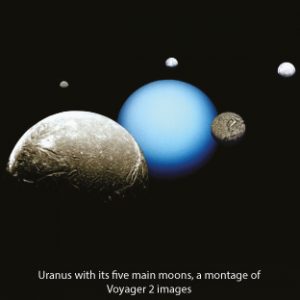Uranus
Huge, icy Uranus is the seventh planet from the Sun and the third largest planet in our Solar System. Ancient observers thought that there were five planets plus the Earth, Sun and Moon. So when William Herschel discovered Uranus in 1781, it was the first time in modern history that another planet had been found.
Uranus and Neptune are often called the ice giants. The atmosphere on Uranus is like Neptune and both are different in composition to Jupiter and Saturn. The atmosphere on Uranus does contain hydrogen and helium but also ice, ammonia and methane. It is the methane that gives Uranus its blue-green colour. Uranus is the coldest planet in the Solar System, with a minimum temperature of –224°C (-371°F).
Uranus is the only planet whose equator is nearly at right angles to its orbit, so it appears to rotate on its side along its orbital path. Like Venus, Uranus rotates east to west and takes 84 Earth years to complete one orbit.
Uranus has 27 known moons all named after characters from the works of the famous authors Shakespeare and Pope. The five main moons are called Miranda, Ariel, Umbriel, Titania and Oberon. Miranda is the smallest of the five main moons and its surface is unlike any other moon we know, with a giant canyon twelve times deeper than the Grand Canyon.
Most of what we know about Uranus is due to the flyby of the Voyager 2 spacecraft in 1986. Uranus was named after the Greek god of the sky.

